- Administrator
- Albums and Singles
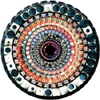 This record was one of the more impressive artifacts to emerge in 2010. Combining music and moving images in a novel way, its uniqueness ensures it will be a talked about collectors item for years to come. Discerning listeners will favor the discombobulated collage aesthetic while visual arts aficionados will be keen to witness the zoetropic animations encoded on the vinyl first hand.
This record was one of the more impressive artifacts to emerge in 2010. Combining music and moving images in a novel way, its uniqueness ensures it will be a talked about collectors item for years to come. Discerning listeners will favor the discombobulated collage aesthetic while visual arts aficionados will be keen to witness the zoetropic animations encoded on the vinyl first hand.
A zoetrope is generally any device that produces the illusion of movement and action from the rapid succession of images, this beautiful picture disc being a case in point. The images on each side are presented in complex concentric rings roughly corresponding to the groove bands of each song. Reuben Sutherland, one half of the duo, is the animator responsible for the bewildering admixture of images. To view the record as a self contained film it is necessary to shine a bright lamp down on the record while watching it on a digital video camera shooting at twenty-five progressive frames per second. The pictures are a melange of abstract kaleidoscopic blurs, TV screens, comics and photographs. Phrases like "is this going to be a presentation of self indulgent paranoia" are also to be seen. The viewer is encouraged to zoom in and out on the LP while moving the camera around which makes the experience all the more wobbly.
The beats emitted from this album have been pickled in salty hallucinatory brine. Swirls of renegade sound are prepared ala carte with generous dashes of malt vinegar, causing my sound system to pucker. This is the kind of electronic music I hadn't known I'd been craving until after the first listen. Hacked 8-bit frequencies are diced and spliced alongside plastic Atari modulated loops progressively modulated with alien reverb. Cheap jungle rhythms are made refreshing when placed alongside damaged kids toys, static hiss, and the lo-fi whirrings so generously distributed across the creatively named songs.
The album opens with a looped flutter and the strained pull of tape across magnetic heads, paused and played, paused and played, fluctuating as the speed starts and slows. Then aleatoric tones, like a child punching greasy digits on a phone for a random prank call, step in as a kind of solo. A big band jazz track makes a quick appearance before disappearing into the grab bag of recycled audio. A good measure of silt and dribbling liquid sounds follow before being thrown in the wash for a quick rumbling spin cycle. Bellowing horn loops are modulated by crisp pitch shifts up and down and the steady staccato of breaks forged on Casio. Every thing is high energy here, moving from one passage to the next easily. Dan Hayhurst, the person responsible for all the noise, has a keen intuition for constructing abstract songs.
The inventiveness of the music is potentially in danger of being overshadowed by the visual aspect of this ambitious piece of work. But like a good music video, the two elements work together synergistically to amplify an effect that would have been good, but not nearly as impressive as single efforts. With the plethora of so many CDs flooding my mailbox at the radio station, press release with download links filling my inbox, more is required of musicians and artists to capture and keep my attention. Sculpture has raised the bar higher not only for themselves but for others who seek the skillful blending of mediums. The creation of Rotary Signal Emitter was an act of vinyl alchemy not easily surpassed.
samples:
Sculpture's vimeo page available here.
Read More
- Administrator
- Albums and Singles
 Supersilent have always lurked at the furthest fringes of jazz, my first recommendations to listen to them usually came from those who were more into Eric Dolphy and Albert Ayler than the kind of stuff I was listening to at the time. With 10, the group have picked out the more traditionally jazzish elements of their improvisations and focused on them. The result is not a straight jazz album, it’s not a straight anything. Labyrinthine but uncluttered, Supersilent again show that they are unwilling to remain in any kind of musical stasis.
Supersilent have always lurked at the furthest fringes of jazz, my first recommendations to listen to them usually came from those who were more into Eric Dolphy and Albert Ayler than the kind of stuff I was listening to at the time. With 10, the group have picked out the more traditionally jazzish elements of their improvisations and focused on them. The result is not a straight jazz album, it’s not a straight anything. Labyrinthine but uncluttered, Supersilent again show that they are unwilling to remain in any kind of musical stasis.
 
The brief "10.1" opens the album and it is easy to imagine this being an unreleased session from Miles Davis’ electric era or indeed an Sun Ra era; Arve Henriksen’s trumpet letting out a strangled drone as a piano tinkles nocturnally. This thread is picked up again on "10.3" as jagged chords on the piano merge with an electric organ and/or a theremin, the overall effect being like what would be a typical ECM release if all the musicians were on ketamine. Later on, "10.7" takes this skewed approach to modern jazz and creates what seems like a forever shifting topography of notes in less than two minutes.
"10.6" and "10.8" reveal another hidden aspect to Supersilent's work: a catchy tune. Granted these two pieces ache with melancholy but it shows a melodic side to a band renowned for eschewing harmony. "10.8" sits somewhere between the trio’s own freeform style, traditional jazz and the blissful sonic blankets of Labradford and Pan•American. It acts as a focal point for 10, balancing everything that makes this album stand out. As it progresses, the natural shaping of the music by the group becomes slowly apparent; like water slowly eroding the landscape, Supersilent erode the silence.
Reinvention has always been key to Supersilent’s existence and their success. Sometimes it pays off (every album to date has been a musical landmark) and sometimes it doesn’t (the one time I saw them live was a bit of a fizzle rather than a bang) and here it has worked remarkably well. Granted I do miss Jarle Vespestad’s drumming (this was the first Supersilent session recorded without him but last year's 9 was also drumless) but the group has always striven for the new and the loss of an integral part to an inventive group can only be the gateway to novel sounds and ways of playing together. 10 is certainly a terrific album, possibly one of their best but I say that about all of them.
samples:
 
Read More
- Administrator
- Albums and Singles
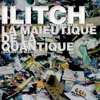 While electronic heavy krautrock inspired jams are far from obscure in this day and age, Ilitch is in the uncommon position of being one of the earlier practitioners of the genre who are still active, and with the vigor they always had.
While electronic heavy krautrock inspired jams are far from obscure in this day and age, Ilitch is in the uncommon position of being one of the earlier practitioners of the genre who are still active, and with the vigor they always had.
Consisting of six songs recorded live in the studio in the span of a single day, there is a definite rawness to the sound that is, as far as I can imagine, completely intentional.Opening "La Maïeutique des Cantiques" even feels more like a warm-up than anything else, with sparse, plucked guitar notes eventually building into a sustained wall, while erratic percussion resembles more of a mic check than any semblance of rhythm.
Once "La Maïeutique de la Quantique" begins, the band is ready to go.Initially a tentative pastiche of nasal synths and stop/start rhythms, it finally opens up wide, letting in aggressive, raw guitar and stuttering analog synths.There is still a sense of pure improvisation going on here, but in no way like the scattershot opening:it is more deliberate and focused.
"Le Cantique de la Maïeutique" isn't quite as successful, focusing on clattering metal and keyboard sound effects.The guitar is still forceful, and eventually develops a big, heavy sound that punctuates its monolithicness with a dose of random noodling.Alas, the track really feels like it "clicks" in its dying minutes:the pieces finally fit together and the beast goes into motion, only to collapse upon its own weight moments later.
The second half feels like the flip side of an LP, as it goes in its own direction, placing a greater emphasis on the rhythms and the textures, a contrast to the more guitar focused "A" side.Even though "La Quantique Des Cantiques" opens with a guitar solo, eventually a rhythmic torrent becomes the focus, with the drummer doing his best Jaki Liebezeit impression for the full duration.While there are a lot of other things going on, my attention was locked on the rapid, evolving rhythms more than anything else.
On the nearly 15 minute "La Quantique de la Maïeutique," there is a culmination of both approaches to the Ilitch sound.Opening with simmering feedback and an insistent synth pulse, the melodic and traditional rhythmic facets stay hidden in the back.Eventually the song builds to a crescendo that sounds like a perverse marching band before retreating back to quiet, arid ambience, with a bit of chaos to close things out.
Given that it is essentially a single day's worth of studio improvisation, the album feels like it has its moments of indulgence and fat that could be trimmed, but even in spite of that it is a strong album.Personally, I feel Ilitch needs to spend more time locking into the groove that they dabble in on the first half of the album, but even with those portions so closely rationed, the disc still works.
samples:
 
Read More
- Administrator
- Albums and Singles
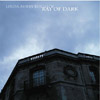
Although she has taken part in a multitude of collaborations, as well as having an impressive resume as a visual artist, this album is Bullock's first true "album" to be released. Consisting of four unified conceptual pieces and two distinct separate ones, Ray of Dark demonstrates a sense of ability that many similar artists strive for in the twilight of their careers.
The first four pieces are solo tracks from Bullock and her bandmates in Twilight of the Century that she reworked, giving each a distinct sound, but also a unifying consistency as well."Navigational Madness," by Rambutan (Eric Hardiman, also of Burnt Hills and Century Plants) drags guitar detritus through submerged amplifier noise, creating a dense mix with infrequent piano-like outbursts, all the while a dirge rhythm clicks away.
Her reworking of husband Michael T. Bullock’s "Line's Dead" focuses on fragments of radio transmissions and distorted electronics, with the occasional heavy rhythmic outburst, with shrill, filtered noises occasionally making their presence known.Fossils From The Sun's "Stage Evil" (Ray Hare, also of Century Plants) takes on a scraping, intense bit of live chaos with carefully rationed feedback and improvised found sounds, resulting in a heavy, but restrained noise piece with occasional outbursts.Bullock's own "Ray of Dark" becomes a miasma of irregular, dubby drum machine beats and noisy guitar squalls, leading into a syrupy set of textures and decaying noise.
Of the remaining two pieces, "The Story of Mike" is by far the lightest moment to be heard here.Field recordings of distant crickets and frogs are met with layered conversations discussing the birth of Mike Bullock in a suitably absurdist manner, eventually with some deep guitar pulses to be heard.The closing "A Specific Gravity" features both Bullocks working together, mixing soft tones with abrasive textures, all the while a mechanical hum fills the air.
Linda Aubry Bullock's "sound" is one that is not easily categorized or pigeon holed, but there is a definite strain of dark, post-industrial experimentalism to be heard: it is as an influence more than as a defining quality.The multitude of sounds and approaches to be heard here are definitely Ray of Dark's strongest feature.While "The Story of Mike" may feel a bit out of place with its more absurdist, comical tone, it works well as a ray of light in an otherwise dark, but compelling album.
samples:
 
Read More
- Administrator
- Albums and Singles
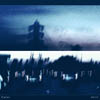 Celer is not the amazing ambient and drone unit that every blog, webzine, and message board in the universe claims it is. At least, Ariill doesn't prove it. Released as a pair of free MP3s in 2007 by Archaic Horizon and presumably related to a self-released CD-R of the same name from 2005, these two half-hour drones represent the start of Celer's prolific four-year run, which I assume yielded better music than this.
Celer is not the amazing ambient and drone unit that every blog, webzine, and message board in the universe claims it is. At least, Ariill doesn't prove it. Released as a pair of free MP3s in 2007 by Archaic Horizon and presumably related to a self-released CD-R of the same name from 2005, these two half-hour drones represent the start of Celer's prolific four-year run, which I assume yielded better music than this.
Following Anthony D'Amico's review of Vestiges of an Inherent Melancholy, I sought out whatever information I could about Celer. All the blogs and message boards I found trading their music made it sound as though Will Long and Dani Baquet-Long's recorded output was a heavenly ambient gospel inspired by the same gods that Jacob Kirkegaard, Chris Watson, and Rosy Parlane proclaimed. Such comparisons and high praise sent me looking for anything I could find by them. Thanks to Archaic Horizon, I didn't have to look far, because they provide Ariill absolutely free of charge on their website.
A paragraph or two can be found there that tries to describe Ariill's central conceit, but it's poorly written and more confusing than helpful. The grandiloquent description only explains that these two pieces began life as piano sonatas and were transformed into something new using a relatively simple looping process the band refers to as "triangular synthesis." There's a diagram included with the download that is supposed to make that process easier to understand, but it's entirely unnecessary and only makes Celer look pompous. Whatever they did to transform their piano music into respiring drone noise, the effort just wasn't worth it.
During the first half-hour, distorted tones, which are stretched to the breaking point, crackle and stutter amidst steaming vents and a rippling, nearly melodic background. The effect is a pleasant one, at least initially, but after 15 minutes it becomes tedious. There is no development, nor is there much in the way of depth, and after just a couple of minutes the song is essentially spent. But Celer keeps the same thing going for an additional 28 minutes. Only very minuscule elements are added or subtracted, so that by the end all I can hear is a repetitive, grating noise, like Charlie Brown's mom speaking through a broken megaphone. It isn't meditative and it isn't poetic, it's just a long, plodding exercise in generic feedback manipulation.
The second half-hour manages to be worse. A single undulating tone begins the song, and over the course of 32 minutes it is transformed by various effects and the addition of other tones, which interfere with it. As these echoing sine waves lap over one another, distorted chunks of audio similar to those from the first song pan across the stereo in short fits. Again, the effect is pleasant enough at the start, but prolonged exposure generates only frustration. Making matters worse are a number of abrupt frequency changes, where the song's central tone is either lowered or raised in a distracting and unpleasant way. Without them the song would be better, but it would still go on for far too long.
With some editing, Ariill might have been a fine EP of under-produced drone, but as a full-length release it is severely flawed. Even in abbreviated form, it would lack the color and ingenuity found so abundantly in the music of people like Andrew Chalk or Jonathan Coleclough (check out Jonathan's Period for an excellent example of highly processed, piano-derived music). It isn't hard to imagine that Will and Dani released better music during their short time together; this is only their second release, after all. But, for now, I have to conclude that if Celer is as great as everyone says they are, the proof is somewhere else, on one of their other 57 releases.
samples:
Read More
- Administrator
- Albums and Singles
 Disappears' 2010 debut (Lux) didn’t connect with me at all, largely because the band's more Neu!-influenced elements were often buried beneath busy, heavily distorted guitars: it wasn't bad, but it didn't conspicuously stand out from a lot of other bands either. This time around, Disappears went with a more spacious sound that places the focus squarely on their killer rhythm section and all of the pieces seem to have now fallen properly into place.  Guider finds a nice balance between precise motorik repetition, muscle, and deadpan urban cool.
Disappears' 2010 debut (Lux) didn’t connect with me at all, largely because the band's more Neu!-influenced elements were often buried beneath busy, heavily distorted guitars: it wasn't bad, but it didn't conspicuously stand out from a lot of other bands either. This time around, Disappears went with a more spacious sound that places the focus squarely on their killer rhythm section and all of the pieces seem to have now fallen properly into place.  Guider finds a nice balance between precise motorik repetition, muscle, and deadpan urban cool.
The basis for "the Disappears sound" seems to have narrowed a bit with this album, as all of the songs except the title piece are built from a propulsive, endlessly repeating mid-tempo groove.  This tendency was much less evident on Lux, as that album was a bit more varied in both tempo and structure.  Variety is not something that suits Disappears very well though, as they tend to be at their best when they cling closest to their formula: guitarists Brian Case and Jonathan van Herik are remarkably adept at assimilating disparate influences in novel ways to keep their very narrow stylistic terrain fresh and compelling.  They have embraced minimalism and restraint in a big way here, effectively filling out the songs with heavily delayed strums, hollow-sounding twangs and tremolo bar dives, simple repeating patterns, and controlled bursts of squalling chaos.  None of those things are new to the band, but they have definitely improved at making them matter through intelligent use of space.
The album's clear centerpiece is the epic "Revisiting," largely because it is the longest piece.  The success of a Disappears song is almost entirely based upon the strength of the groove and how long it is allowed to unfold and "Revisiting" hits the mark on both counts, pulsing hypnotically for nearly 16 minutes.  "Not Romantic" and "New Fast" also lock together quite impressively, but they end too soon to achieve similar levels of snowballing power.  I actually find the song lengths to be a bit puzzling and arbitrary, as most of the album's six songs last just three minutes or under, which suits the punchier, more "garage rock" pieces like "Guider," but seems frustratingly insufficient for some of the others.  Limiting the album to just six songs was a good idea though, as Disappears songs tend to blur together in large doses (there are some great songs buried on Lux that I missed initially).
The primary downside to Disappears, however, is that strong songwriting is not a clear priority: the emphasis is on style and attitude rather than content, which inhibits how far these songs can insinuate themselves into my consciousness.  Fortunately, the band undeniably excels at the extremely specific thing that they do: if I were making a movie that had a scene where a totally bad-ass band was ripping it up in a sweaty club, these guys would be obvious candidates.  Also, it seems like their limited effort towards songcraft is very deliberate, as it's not like vocalist Brian Case tried to write catchy hooks and great lyrics and failed.  Instead, he seems to alternate between a chant-like monotone and urgent post-punk shouting in order to avoid distracting from the groove with anything at all approaching melody.  Disappears are not trying to make an emotional connection–they are trying to rumble over listeners like a damn train (albeit a somewhat art-damaged one).
Notably, Guider is the band's final album with drummer Graeme Gibson, a huge setback for a band so single-mindedly devoted to krautrock-influenced grooves.  Fortunately, Sonic Youth's Steve Shelley has stepped in to temporarily fill the void, so I have no immediate concerns about these guys losing their impressive momentum anytime soon.
Samples:
 
Read More
- Administrator
- Albums and Singles
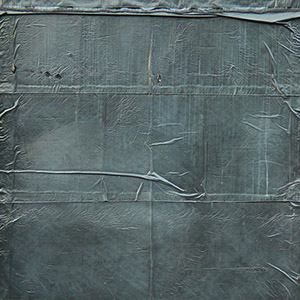 These two recent releases from Garet both showcase drastically different styles and compositional methods. Meta, a single 52 minute piece derived from a four channel installation, does an excellent job of conveying the original’s work of physical space. The other, 60' Cassette, is exactly what it sounds like: an hour long work derived completely from magnetic tape in various states of disarray. Even though the work represents two extremes, Garet's adeptness as an artist and composer results in two significantly different, but equally wonderful works.
These two recent releases from Garet both showcase drastically different styles and compositional methods. Meta, a single 52 minute piece derived from a four channel installation, does an excellent job of conveying the original’s work of physical space. The other, 60' Cassette, is exactly what it sounds like: an hour long work derived completely from magnetic tape in various states of disarray. Even though the work represents two extremes, Garet's adeptness as an artist and composer results in two significantly different, but equally wonderful works.
Meta's initial intent and construction was to draw out everyday, mundane background noises and place the focus on them.The original installation encouraged movement between the four sound sources, and to experience the sounds directly, as well as through objects and from a more significant distance.Of course being mixed down to a stereo CD hinders the original artistic vision, but Garet does an admirable job at capturing the dynamic shifts and evolutions into this format.
Unsurprisingly then, much of Meta is made up of quiet, distant vibrations, subtle noises, occasional buzzing, and at times abrasive scraping.Given its conceptual nature, he conjures images of buzzing florescent lights, loose air conditioning ducts and humming vehicles in the distance.Some passages sound as if they are coming from the ultrasonic spectrum:vibrations that are seemingly less heard and more felt, both at extreme high and low frequencies.As a whole it has a grey, concrete and steel feeling to it and despite its non-intrusive nature, it never becomes forgettable or easily ignored.
samples:
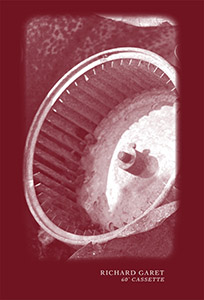
While Meta is defined largely by its use of space and quiet, 60' Cassette is as direct and blunt as its title would insinuate.The first side of the tape immediately begins with loud textures built from sputtering motors and crackling magnetic tape.White static rapids crash throughout as the occasional fragments of what sounds like voice or whatever was previously recorded on an erased tape slip through walls of decay and interference.Garet mangles his magnetic source material into passages of crackling wood or heavy rain, constantly moving and never standing still.
The second half of the tape lightens up on the crunch (though some drastic crashes and bangs cut through at the onset) and instead puts a focus on tone and space.Wet bursts, buzzing bees, and patterns of noise break up moments of tonal shimmering.As the piece goes on, Garet generates echoing, cavernous space teeming with ambiguity, and later into frigid, windswept tundra.
Between Meta's construction from the mundane and the everyday into a largely hushed, quiet electronic composition and 60' Cassette’s forceful and violent sounds of decay and deconstruction, Richard Garet captures two distinctly different extremes in the world of sound art.Perhaps most impressive then is the fact that he tackles the dichotomy so brilliantly, with both being exceptional in their diversity and quality.While my personal bias may lean more towards that analog crunch that is all over the cassette release, the cold purity of Meta is no less exceptional.
samples:
 
Read More
- Administrator
- Albums and Singles
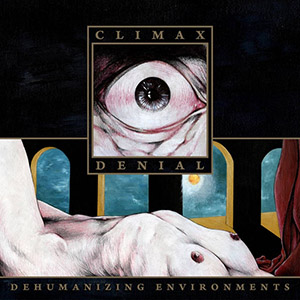 Much of Milwaukee artist Climax Denial’s previous work has drawn heavily from that fetish tinged sleaze aesthetic that has been prevalent in the genre since its inception decades ago. However, divorced of all that, Dehumanizing Environments is a complex, varied work that emphasizes both disorder and structure, coming together in a nuanced, diverse approach that results in a high water mark for aggressive electronic music.
Much of Milwaukee artist Climax Denial’s previous work has drawn heavily from that fetish tinged sleaze aesthetic that has been prevalent in the genre since its inception decades ago. However, divorced of all that, Dehumanizing Environments is a complex, varied work that emphasizes both disorder and structure, coming together in a nuanced, diverse approach that results in a high water mark for aggressive electronic music.
Climax Denial’s harsh predilections are never far away on Dehumanizing Environments, of course.Distortion, belligerent analog electronics and a sense of unpleasant darkness pervades through all four of these pieces.Those features do not define the record though, which is exactly why it is so commendable."The Womb as Vestibule" may open the album with a deep rumble and a synth passage with all the subtlety of a buzzsaw, yet significant depth lurks around the harshness.Icy tones pass through with a sense of melody, and through the harshness there lies open passages and an overall song-like approachof structure and composition.
The following "Fingering Dead Ashes as Evidence" may have a more crude title, but the music is the opposite.Combining rumbling low end and less abrasive mid-range passages of electronics, melodic sweeps drift in an out over the noisier moments.CD continues expanding and evolving the sound, blending beautiful tones with ugly noise, building to a heavier, denser conclusion.The lighter synths that introduce "Morning Following Dried Blood" make for a bit of a false start, as harsher passages are added.Between the overall dark and dour mood and violent, stuttering electronics, the piece is an unsettling, yet extremely captivating.
The penultimate piece, "Environments for Paranoid Necrotic Masturbation", besides sounding like a Carcass b-side, is the already strong album's high point.Glassy, vibrating drones set the stage, along with an extremely loud bass-heavy passage that is physically intense, testing the limits of any good subwoofer.Vocals appear for the first (and only, as best as I can tell) time on the album, and rather than the expected violent and processed screaming it is instead calm and spoken.While the effects render the actual words nearly impossible to decipher, it is that calmness that makes them all the more disturbing. This small snippet of humanity, lurking behind and orchestrating all the bleakness and darkness that surrounds the album, makes it all the more terrifying.
Given the paraphilliac subject matter and sense of pervading malignance throughout Dehumanizing Environments, the more open moments conjure a greater sense sense of impending doom or tension than any sort of peaceful release.But rather than being an album of rote distortion and canned violence, CD crafts a more diverse approach and actually composes, rather than just blurting out guitar pedal blasts of noise.This unexpected depth, coupled with the unsettling overall mood, comes together as an exceptionally strong record.
samples:
 
Read More
- Administrator
- Albums and Singles
David has offered me the opportunity to introduce my book, Seasons They Change: The Story of Acid and Psychedelic Folk. It’s a long narrative of the innovations in folk music from the 1960s to the present day, covering the artists often called ‘acid folk’, as well as the wider story of experimental attitudes to folk music over the decades. I interviewed over a hundred artists for the book including David Tibet/Current 93, and many with whom David has collaborated – Shirley Collins, Clodagh Simmonds, Bill Fay and Simon Finn. Other artists covered include Comus, Vashti Bunyan, Espers, Pearls Before Swine, Dredd Foole, Stone Breath, Devendra Banhart, The Tower Recordings, Incredible String Band, Alasdair Roberts, Donovan, Holy Modal Rounders, C.O.B., Pat Kilroy, Mark Fry, Josephine Foster, Islaja, Tim Buckley, The Sun Also Rises, Joanna Newsom, Fern Knight, Marissa Nadler, Simon Finn, Tyrannosaurus Rex, Perry Leopold, Sonja Kristina, Trader Horne, Bread Love & Dreams, Linda Perhacs, Trees, Sharron Kraus, The Owl Service, Mellow Candle, Will Oldham, Circulus, Jane Weaver, Vetiver, Forest, Susan Christie, Dr Strangely Strange, Lau Nau, Spires That In The Sunset Rise… and many, many, many more. The book can be bought from major booksellers across the UK and US, online retailers, Rough Trade and other record shops, and can always be ordered from your local independent bookstore. And below is the official press release by the publishers: In the late 60s and early 70s the inherent weirdness of folk met switched-on psychedelic rock and gave birth to new, strange forms of acoustic-based avant garde music. Artists on both sides of the Atlantic, including The Incredible String Band, Vashti Bunyan, Pearls Before Swine and Comus, combined sweet melancholy and modal melody with shape-shifting experimentation to create sounds of unsettling oddness that sometimes go under the name acid or psych folk. A few of these artists – notably the String Band, who actually made it to Woodstock – achieved mainstream success, while others remained resolutely entrenched underground. But by the mid-70s even the bigger artists found sales dwindling, and this peculiar hybrid musical genre fell profoundly out of favour. For 30 years it languished in obscurity, apparently beyond the reaches of cultural reassessment, until, in the mid-2000s a new generation of artists collectively tagged ‘New Weird America’ and spearheaded by Devendra Banhart, Espers and Joanna Newsom rediscovered acid and psych folk, revered it and from it, created something new.
 A wonderful, imaginative, insightful and comprehensive book written by my friend Jeanette Leech has just been published. It is highly recommended by me! I asked Jeanette to write something for the Coptic Cat website, which follows:
A wonderful, imaginative, insightful and comprehensive book written by my friend Jeanette Leech has just been published. It is highly recommended by me! I asked Jeanette to write something for the Coptic Cat website, which follows:
Thanks partly to this new movement, many original acid and psych folk artists have re-emerged, and original copies of rare albums command high prices. Meanwhile, both Britain and America are home to intensely innovative artists continuing the tradition of delving simultaneously into contemporary and traditional styles to create something unique.
Seasons They Change tells the story of the birth, death and resurrection of acid and psych folk. It explores the careers of the original wave of artists and their contemporary equivalents, finding connections between both periods, and uncovering a previously hidden narrative of musical adventure.
Author
Jeanette Leech is a writer, researcher, DJ and music historian. She writes regularlyfor Shindig! magazine, and as part of the B-Music collective she has DJ’d throughout the UK, including at the female acid folk events known as ‘Bearded Ladies’ and the Green Man Festival. She writes extensively in the health and social care fields. Seasons They Change is her first book about music.
Read More
- Administrator
- Albums and Singles
 Turntable artist Philip Jeck has a long history of crafting rich and absorbing albums with a very distinctive style, so I was very much looking forward to hearing a new opus from him, especially given that he has not released anything particularly substantial since 2010's excellent An Ark for the Listener.  Sadly, Cardinal is not quite the album I was hoping for, as it is not so much a painstakingly composed masterpiece as it is a unconventional catch-all for a bunch of unreleased live highlights, soundtrack commissions, and stray home-recorded material.  Some of the pieces are quite good, so I have no qualms at all about the album being released, but Cardinal is necessarily a much more fractured, disorienting, and exhausting experience than any of Jeck's recent proper albums.
Turntable artist Philip Jeck has a long history of crafting rich and absorbing albums with a very distinctive style, so I was very much looking forward to hearing a new opus from him, especially given that he has not released anything particularly substantial since 2010's excellent An Ark for the Listener.  Sadly, Cardinal is not quite the album I was hoping for, as it is not so much a painstakingly composed masterpiece as it is a unconventional catch-all for a bunch of unreleased live highlights, soundtrack commissions, and stray home-recorded material.  Some of the pieces are quite good, so I have no qualms at all about the album being released, but Cardinal is necessarily a much more fractured, disorienting, and exhausting experience than any of Jeck's recent proper albums.
Given its wide-ranging origins, Cardinal is a surprisingly cohesive album, covering several years of performances spanning an impressive swath of the Western world (Austria, England, North America, Greece, etc.).  A large part of that success is presumably because Jeck did a lot of re-editing and reworking of the material, but these 13 pieces nevertheless feel weirdly like they belong together.  Not in the expected way, however, as Cardinal feels a lot like a deliberately misassembled jigsaw puzzle.  That seems to have been a curious and intentional move on Jeck's part, as none of pieces that are related to one another are presented together or in their original order.  For example, the live soundtrack for Guy Maddin’s Cowards Bend at the Knee is included as a Part One and a Part Five with three unrelated songs between them.  Consequently, the "Bends the Knee" pieces are not just separated from their original context, they are also decontextualized from each other and recontextualized to serve the sequencing of Cardinal.
That intentional jumbling is a very bold and counterintuitive move, which I can certainly appreciate: Jeck's strength has always been the thought and cohesiveness that goes into his compositions.  Cardinal gutsily goes in an opposite and uncharacteristically kaleidoscopic direction, which unsurprisingly yields mixed results.  On the one hand, Cardinal is a wildly unpredictable, vibrant, and varied album, as any given piece is equally likely to feature warmly crackling drones; warped experimentation; or harsh, nightmarish cacophony.  On the other hand, that means that the ground is constantly shifting under my feet as a listener.  I certainly enjoy surprises and challenging listening experiences more than most people, but one thing I have never been able to embrace has been rapid transitions between disconnected themes.  If anything can happen at any time, nothing can have much meaning.
That said, there are plenty of promising and enjoyable pieces throughout Cardinal, but they all feel like false starts or mere oases in a sea of chaos.  It is impossible to get absorbed in a piece when I know that it is doomed to never truly evolve or develop.  For example, three minutes of the cavernous and throbbing drone of "Saint Pancras" is certainly wonderful, but it would be a lot better if it segued into the rest of Jeck's St. Pancras Church performance rather than a shuddering, moaning, and ominous excerpt from the Full of Noise festival.  Jeck's music offers little in the way of rhythm, melody, or harmony, so taking away a couple of the few things that it does offer (depth and immersiveness) is bound to cause problems.  Cardinal basically feels like restlessly channel-surfing through all of the cool sounds that Jeck can create.
I recognize that such an aesthetic has its appeal (people sure seem to like Oneohtrix Point Never), but it largely leaves me cold.  I still mostly like Cardinal though, albeit in a cerebral rather than gut-level way.  Jeck definitely tried to do something different here, as this is neither another predictably stellar Philip Jeck album nor is it a mere compilation.  It is something in-between and it is also compelling art, despite its significant weaknesses as a pure listening experience.  I would probably have loved it if Jeck had made Surf, Part Two instead of Cardinal, so it is admirable that he opted not to repeat himself and chose instead to make a disorienting, precarious hall of mirrors of an album that no one saw coming.  I can respect that Cardinal is primarily an interesting experiment and a curious window into some of the artist’s darker, noisier impulses.  It may not rank among his finest releases, but the consolation prize is that it at least deepened my appreciation for Jeck's artistry and willingness to attempt some bold new twists this deep into his career.
Samples:
 
 
Read More
 Perhaps a little bit too superfluous, being a little bit different from more droney music albums, which maybe a good thing, but in this case, it works against itself.  This is an experimental improv album featuring an out of place Madonna sample, not once, but twice on two separate tracks. The samples seem to be random and kind of annoying sometimes and it makes the listener turn their heads, as if almost saying, "Was that Madonna I heard between the blips and bloops?"
Perhaps a little bit too superfluous, being a little bit different from more droney music albums, which maybe a good thing, but in this case, it works against itself.  This is an experimental improv album featuring an out of place Madonna sample, not once, but twice on two separate tracks. The samples seem to be random and kind of annoying sometimes and it makes the listener turn their heads, as if almost saying, "Was that Madonna I heard between the blips and bloops?"


